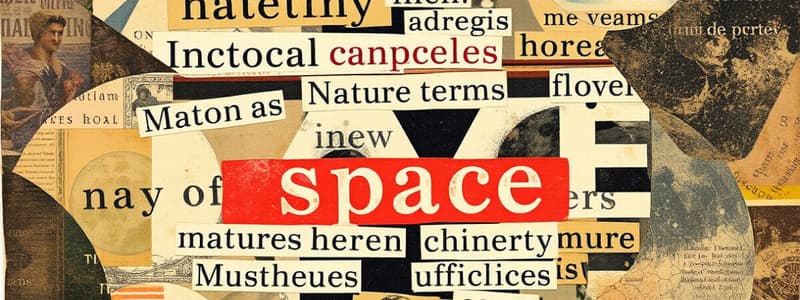Podcast
Questions and Answers
What is the first stage in the life cycle of a star?
What is the first stage in the life cycle of a star?
- White dwarf
- Nebula (correct)
- Red giant
- Protostar
What occurs when nuclear fusion starts in a protostar?
What occurs when nuclear fusion starts in a protostar?
- The star becomes a black dwarf
- The star is classified as a main sequence star (correct)
- The star enters the red giant phase
- The star transforms into a neutron star
What forms when a low or medium mass star exhausts its hydrogen fuel?
What forms when a low or medium mass star exhausts its hydrogen fuel?
- Red super giant
- Planetary nebula (correct)
- Black hole
- Neutron star
What is the outcome of a supernova?
What is the outcome of a supernova?
Which stage follows the main sequence star phase?
Which stage follows the main sequence star phase?
What happens to the core after a red super giant star explodes?
What happens to the core after a red super giant star explodes?
What is the final stage of a low or medium mass star?
What is the final stage of a low or medium mass star?
Which hypothesis describes the formation of stars from clouds of gas and dust?
Which hypothesis describes the formation of stars from clouds of gas and dust?
Flashcards are hidden until you start studying
Study Notes
Jumbled Words Activity
- Activity challenges recognition of words related to astronomy.
- Examples include simple words like "GAS," "LARGE," "STARS," "DUST," "CLOUDS," "PLANETS," and "GALAXY."
Theories on the Origin of the Universe
- Various theories exist to explain the universe's beginnings.
- Steady State Theory proposes a constant density of matter over time.
- Planetesimal Hypothesis suggests planets formed from small solid particles.
- Tidal Theory involves gravitational interactions leading to the formation of celestial bodies.
Life Cycle of a Star
- All stars originate from a nebula, a vast cloud of gas and dust.
- Gravity consolidates material in the nebula, forming a protostar, the initial stage of a star.
- Nuclear fusion ignites when the protostar becomes hot enough, marking the birth of a main sequence star.
- As a main sequence star exhausts hydrogen, it becomes a red giant or red supergiant.
Death of a Low or Medium Mass Star
- A red giant sheds its outer layers, creating a planetary nebula.
- The remaining core cools and becomes a white dwarf.
- Eventually, the white dwarf depletes its fuel and becomes a black dwarf, marking the end of its life.
Death of a High Mass Star
- A red supergiant can end its life in a dramatic supernova explosion.
- Post-explosion, remnants may form a neutron star, composed mainly of neutrons.
- The most massive stars may collapse into black holes, representing the ultimate endstate of high-mass stellar evolution.
Studying That Suits You
Use AI to generate personalized quizzes and flashcards to suit your learning preferences.



